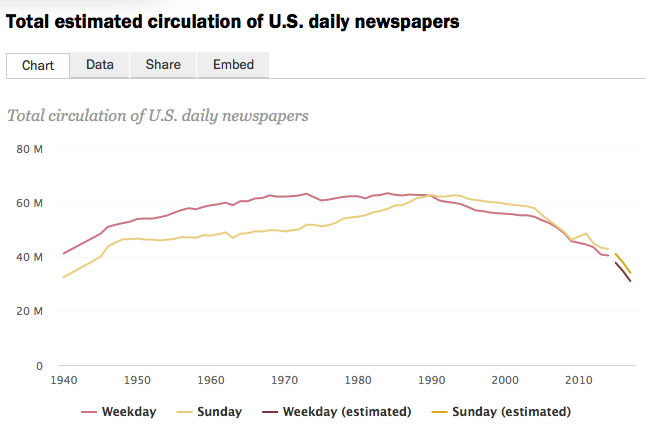
The 2018 State of the News Media annual report released by the Pew Research Center takes an analytical look at the everchanging ways individuals are receiving news. From up-and-coming podcasts to declining print coverage, the report discusses the fluctuating ideals of the human relationships with the press. One of the more interesting elements of the report was the visual look at how print journalism is declining. While this isn’t a new subject, it is revealing to attach real numbers and images with the downfall.
At its peak, print news was flourishing. It was the way a majority of citizens across the United States received information. Now, in the age of digital news, newspapers and even magazines have been kicked to the curb for easier, cheaper methods of news intake. Real journalism has taken a hit for being “fake news,” only further striking down the print media that brought journalism to the forefront decades ago. The chart below (provided by the Pew Research Center) visualizes the decline of newspaper circulation since 1940.
Then, the most shocking: the decrease in employment. It’s no secret that newsrooms are shrinking and jobs are being eliminated, but when looking at numerics it is clear how abrupt the drop-off is. I realized quickly that a major component for the dwindling newsroom jobs has much to do with the 2008 recession. This is evident in the Pew Research Center graph below. The biggest fallout for newsrooms came in the year 2008, and it’s been on a steady decline ever since.

While the decline of print journalism is often a painful truth for journalists and aspiring media professionals, it can be overshadowed by the positive changes in the industry. Podcasts are booming, and this is an intake of news that was barely enjoyed in previous years. While it’s not all hard news, it is still creating jobs for those in the field of journalism. This also allows individuals to take a more creative spin with their skills. Children as young as 12 years old are common podcast listeners as revealed by the report in the graph pictured below.

I think these changes in the models in which we receive our news can provide hope; not only hope for the great things already in place helping the public receive news in creative ways, but hope for what is to come. The next big thing can be scary at first, often even denied, but next thing you know it can take over the industry. If podcasts are today’s big thing and one of the stronger method of receiving news, what will come next?
Here we are today, where the average individual tends to get a majority of their news from Snapchat stories and Facebook posts. We went from awaiting the Sunday paper for the next big story to being able to produce news ourselves by sending out a 140 character tweet. This is often viewed in a negative light, yet it’s made our country more aware of issues taking place overseas and helped catch criminals. We are in a new era, and there is only more innovation and creation to come – whatever that looks like.

I really like your writing style! This was a great, digestable summary of the Pew Research survey. You’re right how it is really revealing that even 12-year-olds are listening to podcasts. It shows how people want content on demand and podcasts are a prime example of that.
LikeLiked by 1 person
I agree the changes in the models do bring hope to a so-called “dying industry”. If we have children age 12 and up listening to podcasts, that is a promise for the future of journalism. In an age where we have a 24-hour news cycle and technology is updating so quickly, journalists need to learn to adapt and change with the people’s new styles all while keeping the same morals and values.
LikeLike